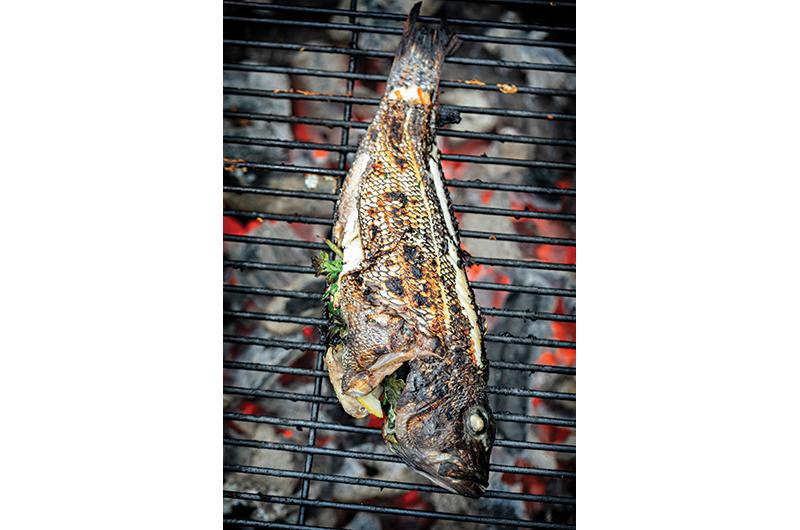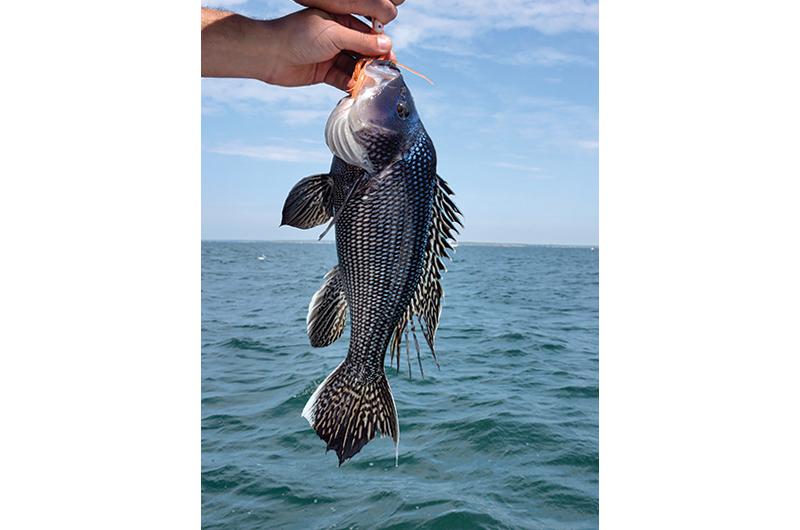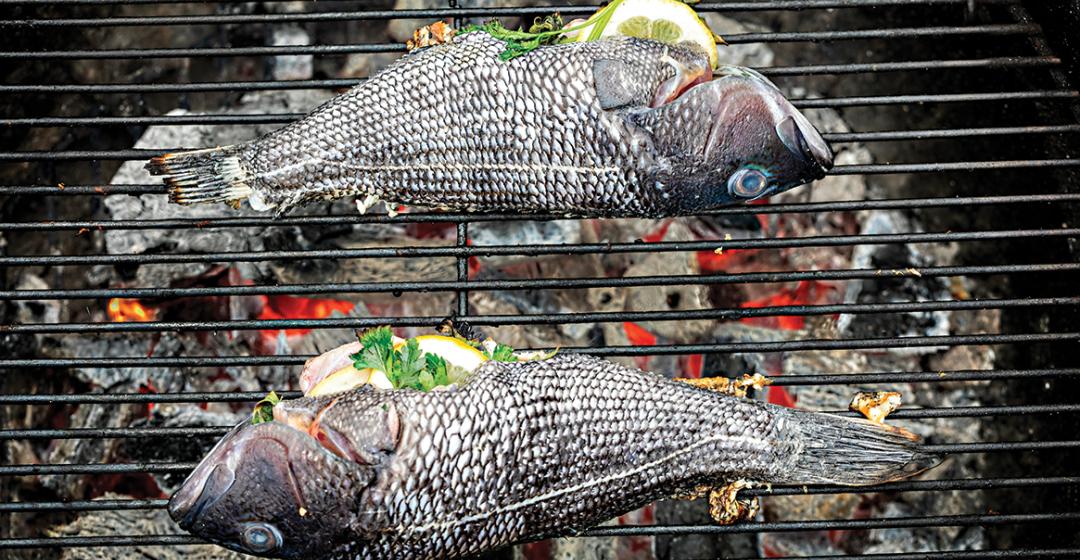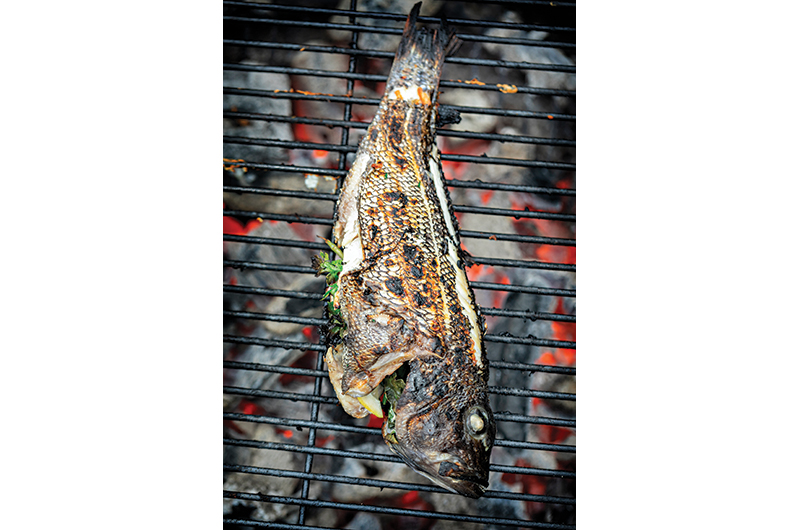Cooking is a constant learning process, with endless new techniques to master and foreign cuisines to decipher. Even after many years of working as a private chef on the Island and preparing seafood, I recently tackled a new technique: cooking whole fish.
It seemed intimidating, and I had zero experience. It’s not something I learned in my training as a chef or at home growing up.
I might not have even tried cooking fish whole if not requested by one of my seasonal clients, who is Italian. It’s a popular and favored technique in Europe, he told me. He was surprised to learn that is not the case here in the states.
After practicing two or three summers, I will report that cooking whole fish – on the grill, stove, or oven – has won me over. There’s a simplicity to tossing a whole fish on a grill, and cooking the flesh on the bone under the skin leaves it flavorful, moist, and tender.
Steven Raichlen, an international grilling and barbecue expert who has traveled the world and lives on Chappaquiddick half the year, says many cultures have traditional methods for cooking fish whole, such as wrapping it in banana leaves before grilling. “Historically, Americans have been squeamish about cooking and eating whole fish in general – not liking the head, eyes, and skin. Then add the traditional challenges of grilling fish: sticking to the grate or falling apart when you turn it.”
This technique may not be for everyone. It’s a more casual, rustic presentation, even a little messy. And there are bones with which to contend. But for adventurous cooks looking to try new techniques or dishes on the grill with delicious results, whole fish should be on their horizon.
The good news is we have several species of fish swimming around the Island that are perfectly suited for cooking whole due to their small to medium size. They include fluke, black sea bass, and scup. All are delicate, mild, and white-fleshed. All three species are also considered sustainable local fish, says Shelley Edmundson, executive director of the Martha’s Vineyard Fishermen’s Preservation Trust, which works to protect the Island’s fishing heritage. “If there’s a large supply being caught and the demand is low, it becomes under-utilized,” Edmundson explains. “It doesn’t mean it’s not delicious and something great to try. It really helps the fishermen when we are buying underutilized fish species that are well regulated. It keeps it here.
“I think it’s great for people to overcome the fear of using whole fish,” she adds. “It makes you more connected to the beauty of what you are eating. You can appreciate it all the more.”
Because I fish, I was able to practice whole-fish cooking on my own family without too much expense. That gave me the confidence to try it on the job. In this scenario, you must work a little for your free food, but it’s a nice experience to get out on the water on a beautiful evening. Should you prefer to go the easier route, most Island fish markets, such as Larsen’s Fish Market in Menemsha, Edgartown Seafood, or The Net Result in Vineyard Haven, will sell you whole fish if requested ahead of time. They will even scale, clean, and prep it for you too.
If you stop by Larsen’s in the morning and peek into the back rooms, you’ll notice they are filleting dozens of black sea bass, as well as fluke. “We do our cutting first thing in the morning,” says owner Betsy Larsen, who suggests calling the day prior to check on availability.
The daughter of a fisherman, whose two brothers also owned local fish markets on the Island, Larsen says there is a Vineyard tradition of cooking whole fish. She upholds that tradition herself.

“My dad used to love nothing better than whole flounder,” she says. “He used to pan-fry it. There’s nothing like eating off the bone – the flavor.”
James Beard Award–winning cookbook author and former Island chef Chris Fischer also frequently prepared and served whole fish. He grilled the day’s catch over open fires as part of his casual dinners at Beetlebung Farm in Chilmark, back when the property was owned by his family. Fischer grew up on the Vineyard eating clams, oysters, and bluefish caught or foraged by his father.
“The roots of cooking whole fish are there, just one or two generations back,” he says. “People used to be a lot more thrifty, cooking a whole fish. It’s a real delicacy.” But now, he concurs with Raichlen, “People are sheepish of seeing the entire animal, and I think that includes fish.”
While he says flounder and other flatfish are good options to cook whole on the grill, Fischer’s personal favorite is bluefish. Stuffed with herbs and lemons, he says: “Bluefish, to me, is the best fish to cook whole. It’s meatier, has less bones, and the fattiness of bluefish allows it to be more succulent.”
I’m still learning about and experimenting with whole fish, but as avid fans and practitioners of the process, Fischer and Raichlen have developed tried-and-true suggestions for getting the best results.
Fischer’s two pieces of advice come at the beginning and the end. “Clean your grill extremely well. Rub your fish with oil, and then season it,” he says. “Let it sit so some of that oil drips off and doesn’t flare up. I think that’s really helpful.”
After the fish comes off the grill, Fischer continues, let it rest, as you would a piece of meat. “The key with whole fish is allowing time for it to rest. It takes away the need to be precise because the skin is going to hold in moisture; it will steam. I would say at least ten minutes is probably ideal.”
On a visit to Chappaquiddick when I last wrote about Raichlen, the author of thirty-two cookbooks, he had a dozen or so different types of grills set up at his home. He says he has grilled lots of fish whole, including local bluefish, fluke, scup, and black sea bass.
“I’ve done them all; I love them all,” he says. Raichlen, whose fourth season of the grilling show Project Fire aired on public television last summer, has even stuffed the cavity of a large striped bass with lemon and herbs and cooked it whole.
Using a grill basket, he says, is a super easy way to grill fish. “The basket keeps the fish from sticking to the grate. You are turning the basket rather than turning the fish. It crisps up the skin and you get nice grill marks.” Cook it for five to ten minutes per side, he suggests.
For larger fish, you can set your grill up for indirect cooking – with the coals on one side, or half of a gas grill turned off. The whole fish goes on the side that is not over the coals. In this scenario, he says, you never need to flip the fish. You can also add wood chips for additional smoky flavor.
Another method Raichlen loves is using a cedar plank – for both whole fish or fillets. “Snappers (the smaller bluefish) can be delicious on a cedar plank, with dill and lemon. I might tie strips of bacon lengthwise on the fish top and bottom.”
Asked whether he prefers charcoal or gas for fish, he says charcoal. He also favors a wood-burning grill, such as one he owns from the brand KUDU, which is more like cooking over an open fire.
I have yet to try that method. Still, armed with these suggestions, I have a feeling this season of cooking whole fish will be my best yet.

Local Fish to Try
Don’t know where to start? The Martha’s Vineyard Seafood Collaborative serves up suggestions for fish to cook whole.
Black sea bass (above) – a small, plump fish related to grouper – has a mild, fresh, somewhat delicate flavor and a tender but firm texture. It is one of the best small fish to bake or grill whole, due to its relatively simple bone structure. The flesh holds together well and can be used in chowders and soups.
Scup – also known as porgy – is an affordable, sustainable, and underutilized species that was popular generations ago. Researchers hope it will make a comeback. Scup has tender white meat with a large flake and a mild, sweet flavor that has been compared to snapper. Its many small bones can make it difficult to fillet. Scup is excellent grilled whole or oven-roasted, since these methods soften the bones and allow the meat to slide off more easily. It’s also good fried, grilled, poached, or used in a ceviche.
Fluke – often labeled Vineyard sole in markets – is popular for its flavor and firm texture and is an excellent alternative to more expensive flatfish species, such as sole. It holds up well to many types of preparations, including frying, grilling, steaming, broiling, and baking. Fillets are commonly served poached or broiled with liquid to keep the thin fluke pieces from drying out.
Whole Fish Grilling 101
Steven Raichlen shares his top ways to cook whole fish over a barbecue.
• Indirect grilling: it spares you from having to turn the fish during grilling, and you can boost the flavor by adding wood chips or chunks to the coals.
• Direct grilling in a basket: the basket prevents the fish from sticking to the grate.
• On a cedar (or other wood) plank or on a salt slab: this helps avoid the problem of the fish sticking to the grill grate, adds extra flavor, and looks great for serving.
• Wrapped in banana leaves or grape leaves: this is an ideal choice for small whole fish, such as sardines.
The following recipes were originally published along with this article:
Grilled Whole Black Sea Bass with Green Herb Sauce
Duccio’s Baked Whole Fluke with Caper Herb Sauce








